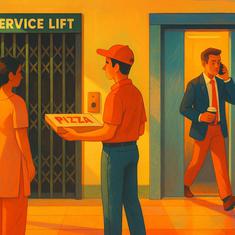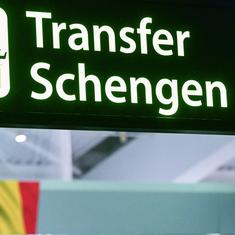The notification of Goa’s Transport Aggregator Guidelines on May 20 once more fanned the heated discussion about taxi operations in the state, prompting tourists, residents and drivers to argue about prices and the regulatory framework for the sector.
Meanwhile, in Bengaluru, bike taxi services came to a grinding halt on June 16 following a High Court directive. In response, app-based aggregators rebranded these services as courier platforms – a move many saw as a thinly veiled attempt to skirt regulation – or quietly removed them altogether.
These episodes have ignited fierce debate across India. Outrage over “taxi mafias” purportedly holding the public to ransom, concerns about job losses and legal grey zones have hit the headlines.
In Goa, critics point to inflated fares and poor service. In Bengaluru, the bike taxi ban has left thousands of gig workers jobless and protesting. In response, some have framed Goa’s taxi setup as a grassroots cooperative – defending territorial control and fixed pricing as a form of collective protection.
At the heart of these developments lies a deeper tension – one that is not just about Goa or Bengaluru but about how urban mobility is governed across India.
Instead of asking whether app-based aggregators like Uber and Ola should be banned or embraced, perhaps we should ask why our cities have failed to build mobility systems that are fair, accountable and inclusive for both drivers and passengers.

India’s urban transport system is characterised by a “paratransit”-dominated landscape, where informal, flexible and often small-scale modes such as autorickshaws and taxis bridge gaps in formal public transit and serve the mobility needs of the majority population.
The country’s paratransit ecosystem – particularly in smaller cities and tourist states like Goa – is rife with inefficiencies, gaps in regulation, and fragmented systems of control. What is often dismissed as cartelisation or mafia-like behaviour is, more often than not, a symptom of deeper policy failures.
In many cities, it is very difficult for new drivers to get legal permits to operate because the number of permits is strictly limited or the permit system is not transparent. These restrictions have fostered grey markets and informal monopolies.
For example, in Delhi, a court ruling in 1997 linked autorickshaw permits directly to vehicle registrations and stopped new registrations. It created an artificially scarce permit-vehicle asset, leading to an opaque permit regime that is easily exploited by vehicle financiers and middlemen.
Similar to Delhi, in many states, court-imposed restrictions on issuing new local taxi permits – intended to control urban congestion – have created a thriving black market for licences. Local cartels have capitalised on these shortages, inflating permit costs far beyond the price of the vehicle itself.
Aggregators such Uber and Ola initially circumvented these restrictions by registering their vehicles under tourist taxi categories, which were not bound by city limits or electronic meter regulations. This allowed them to not just break taxi monopolies but also to flood the market with vehicles, leading to oversupply and plummeting driver incomes.
It is not uncommon to hear that app-based aggregators “empower” drivers by offering flexible work. But this empowerment narrative has long frayed. The early days of subsidised rides and bonuses have given way to drivers paying aggregators high commissions (sometimes over 30%) even as they receive diminishing returns.

Moreover, the algorithmic control exercised by aggregators, such as disabling drivers’ access to apps or complicating rejection of ride requests, erodes drivers’ autonomy, allows surveillance and pressure and obscures their decision-making abilities.
Today’s platform economy is no longer about disrupting monopolies – it is about consolidating new ones, with far greater reach, opacity and power. And when regulation finally steps in, as in the case of Bengaluru’s bike taxi ban, it is the gig workers – not the companies – who are left to shoulder the uncertainty.
This does not mean we should romanticise existing taxi practices either. The “return fare” rule, where Goan taxi drivers charge extra for the empty return trip, is often explained as part of a cooperative code of conduct. But in practice, it entrenches territorial divisions that resemble turf protection more than genuine solidarity.
It is inefficient, environmentally wasteful and exacerbates the very access issues tourists and residents complain about. It is no surprise that resentment builds when passengers face high fares, limited availability and arbitrary rules – particularly when drivers are labelled as lazy or exploitative.
By keeping taxi operators, aggregators and passengers in constant conflict, governments and courts position themselves as neutral arbiters of the sector. But this perceived neutrality often allows them to avoid accountability for the deeper problems in the system.
Instead of taking responsibility for building fair and functional transport networks, they respond to crises piecemeal – stepping in just enough to manage disputes without addressing the root causes.
This not only shifts the blame away from policymakers but also gives them greater power to shape outcomes without being held to account for the long-term effects of their decisions.
Blanket bans on aggregators are not the answer. Nor is unchecked platform expansion. The real task is to build public systems that treat mobility as a right, not a market opportunity.
The relative success of initiatives like the Namma Yatri app for autorickshaws and taxis in Bengaluru shows that alternatives are possible. Developed by two IIM Bangalore graduates with open-source principles and a no-commission model, it has offered a platform that is more transparent, accountable and driver-friendly.
Crucially, it has also pushed larger aggregators to rethink exploitative commission-based models in favour of subscription-based ones – at least for two- and three-wheelers. Instead of charging a proportional commission for every ride, the subscription-based models allow the drivers to take unlimited rides for a flat daily fee or charge a flat rate for every booking irrespective of the distance travelled.
It provides drivers with higher earnings, ownership, freedom and agency, while simultaneously reducing the cost burden on passengers.
If taxi services in Indian cities are to be reformed, the focus must shift from binary choices (aggregator vs local taxi) to preventing the conditions that give rise to monopolies of any kind.
We need regulatory frameworks that dynamically assess demand, regularly and transparently revise fare structures and empower drivers not just as gig workers but as transport service providers with rights and representation.
The term “taxi mafia” simplifies what is, at its core, a governance crisis. Yes, there are exploitative practices. But they are neither inevitable nor unique to traditional taxis. Platform monopolies are not immune to them – they just operate with better PR and deeper pockets.
India’s urban mobility future should not be left to turf wars between taxi cabals and techno-feudal corporations. It should be co-created with workers, planners, regulators, and commuters.
That requires moving beyond sensational labels to grapple with the harder work of reforming how we govern transport in our cities.
Gaurav Mittal is a researcher at the Transport Studies Unit, University of Oxford.










